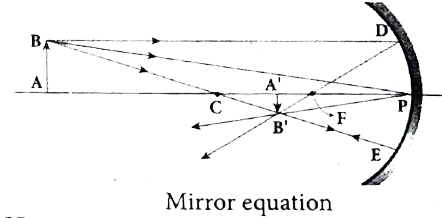Obtain the equation for lateral magnification for thin lens.Solution in Tamil
The mirror equation establishes a relation among object distance u, image distance v and focal length f for a spherical mirror . An object AB is considered on the principal axis of a concave mirror beyond the center of curvature C.
Let us consider three paraxial rays from point B on the object .
The first paraxial ray BD travelling parallel to principal axis is incident on the convave mirror at D , close to the pole P. After reflection the ray passes through the focus F . the second paraxial ray BP incident at the pole P is reflected along pB . The third paraxial ray BC passing through centre of curvature C falls normally on the mirror at E is reflected back along the same path
The three reflected rays intersect at the point B . A perpendicular drawn as A. B. to the principal axis is the real , inverted image of the object AB.
As per law of reflection , the angle of incidence ∠BPA is equal to the angle of reflection ∠B.PA. . The triangles ΔBPAandΔB.PA. are similar. thus from the rule of similar triangle ,
A.B.AB=PA.PA .........(1)
The other set of similar triangle are ΔDPFandΔB.A.F (PD is almost a straight vertical line )
A.B.PD=A.FPF............(2)
From equations (1) and (2) we can write,
PA.PA=A.FPF
As A.F=PA.-PF the above equation becomes,
PA.PA=PA.−PFPF ..........(3)

We can apply the sign convertions for the various distances in the above equation.
PA=−u,PA.=−v,PF=−f
All the three distance are negatives as per sign convention, because they are measured to the left of the pole. Now the equation (3) becomes.
−v−u=−v−(−f)−f
On further simplification,
vu=v−ff,vu=vf=1
Dividing either side with v,
1u=1f−1v
After rearranging,
1v+1u=1f ........(4)
The above equation (4) is called mirror equation.
Lateral magnification in spherical mirrors
The lateral or trasverse magnification is defined as the ratio of the height of the image to the height of the object. The height of the object and image are measured perpendicular to the principal axis.
magnification (m) =height of the image(h.)height of the object (h)
m=h.h .........(5)
Applying proper sign conventions for equation (1)
A.B.AB=PA.PA
A.B.=−h,AB=h,PA.=−v,PA=−u
−h.h=−v−u
On simplifying we get,
m=h.h=−vu
Using mirror equation, we can further write the magnifications as
m=h.h−f−vf=ff−u
Topper's Solved these Questions
- BOOK - FULL MARKSCHAPTER - SAMPLE PAPER -4 (SOLVED)EXERCISE - PART-III9videos
SAMPLE PAPER -4 (SOLVED)
- BOOK - FULL MARKSCHAPTER - SAMPLE PAPER -14 (UNSOLVED)EXERCISE - PART-IV9videos
SAMPLE PAPER -14 (UNSOLVED)
- BOOK - FULL MARKSCHAPTER - SAMPLE PAPER 3 (SOLVED)EXERCISE - PART- IV10videos
SAMPLE PAPER 3 (SOLVED)
Similar Questions
A sample of HCI gas is placed in a uniform electric field of magnitude 3×104N.C−1 . The dipole moment of each HCI molecule is 3.4×10−39 Cm. Calculate the maximum torque experienced each HCI molecule.
04:54View SolutionExplain the equivalent resistance of a series and parallel resistor network.
09:11View SolutionExplain in detail the construction and working of a Van de Graaff generator.
09:11View SolutionThe rays passing through the optic centre of a thin lens suffers no lateral displacement.
08:00View SolutionObtain the equation for lateral magnification for thin lens.
07:40View SolutionObtain the equation for lateral magnification for thin lens.
09:11View SolutionDerive the equation for thin lens and obtain its magnification .
09:11View SolutionDerive the equation for lateral magnification in spherical mirrors.
09:11View SolutionObtain the equation for lateral magnification for thin lens.
08:00View SolutionObtain the equation for lateral magnification for thin lens.
11:41View SolutionObtain the equation for lateral magnification for thin lens.
02:24View SolutionDerive the equation for thin lens and obtain its magnification .
04:29View SolutionObtain the equation of thin lens.
02:02View SolutionObtain the magnification by lens after giving its definition.
52:11View SolutionWrite equation and definition of lateral magnification for lens.
05:33View Solution

